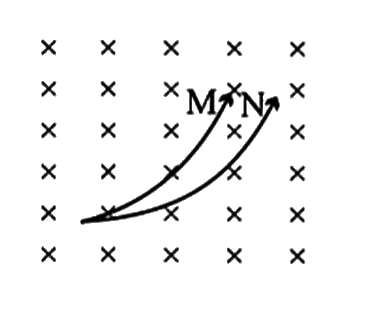A particle of specific charge q/m=(π)C/kg is projected from the origin towards positive x-axis with a velocity of 10m/s in a uniform magnetic field →B=−2ˆK Tesla. The velocity →V of the particle after time t=1/6 s will be
(5ˆi+5√3ˆj)m/s
10ˆJm/s
(5√3ˆi−5ˆj)m/s
−10ˆjm/s
The correct Answer is:a
To solve the problem, we need to determine the velocity of a charged particle after a certain time when it is projected in a magnetic field. Here is the step-by-step solution:
Step 1: Understand the motion of the particle
The particle is projected with an initial velocity →V0=10m/s along the positive x-axis. The magnetic field is given as →B=−2^k Tesla, which means it is directed along the negative z-axis.
Step 2: Determine the specific charge
The specific charge of the particle is given as qm=πC/kg.
Step 3: Calculate the magnetic force
The magnetic force acting on the particle can be calculated using the formula:
→F=q(→V×→B)
Since the particle is initially moving in the x-direction and the magnetic field is in the z-direction, the force will act perpendicular to both the velocity and the magnetic field.
Step 4: Determine the angular velocity
The angular velocity ω of the particle in circular motion due to the magnetic field is given by:
ω=qBm
Substituting qm=π and B=2:
ω=π×2=2πrad/s
Step 5: Calculate the time period
The time period T of the circular motion can be calculated as:
T=2πω=2π2π=1s
Step 6: Calculate the angle rotated in t=16 s
The angle θ rotated in time t is given by:
θ=ωt=2π×16=π3radians
Step 7: Determine the new velocity components
The initial velocity vector is:
→V0=10^im/s
After rotating through an angle of π3 (or 60 degrees), the new velocity components can be calculated using trigonometric functions:
→V=|→V0|(cos(π3)^i+sin(π3)^j)
Calculating the components:
- cos(π3)=12
- sin(π3)=√32
Thus,
→V=10(12^i+√32^j)=5^i+5√3^jm/s
Final Answer
The velocity of the particle after t=16 s is:
→V=5^i+5√3^jm/s
The particle is projected with an initial velocity →V0=10m/s along the positive x-axis. The magnetic field is given as →B=−2^k Tesla, which means it is directed along the negative z-axis.
The specific charge of the particle is given as qm=πC/kg.
The magnetic force acting on the particle can be calculated using the formula:
→F=q(→V×→B)
Since the particle is initially moving in the x-direction and the magnetic field is in the z-direction, the force will act perpendicular to both the velocity and the magnetic field.
The angular velocity ω of the particle in circular motion due to the magnetic field is given by:
ω=qBm
Substituting qm=π and B=2:
ω=π×2=2πrad/s
The time period T of the circular motion can be calculated as:
T=2πω=2π2π=1s
The angle θ rotated in time t is given by:
θ=ωt=2π×16=π3radians
The initial velocity vector is:
→V0=10^im/s
After rotating through an angle of π3 (or 60 degrees), the new velocity components can be calculated using trigonometric functions:
→V=|→V0|(cos(π3)^i+sin(π3)^j)
Calculating the components:
- cos(π3)=12
- sin(π3)=√32
→V=10(12^i+√32^j)=5^i+5√3^jm/s
The velocity of the particle after t=16 s is:
→V=5^i+5√3^jm/s
Topper's Solved these Questions
- MAGNETIC EFFECT OF CURRENT AND MAGNETISMBOOK - DC PANDEY ENGLISHCHAPTER - MAGNETIC EFFECT OF CURRENT AND MAGNETISMEXERCISE - More than One Option is Correct
25 Videos
- MAGNETIC EFFECT OF CURRENT AND MAGNETISMBOOK - DC PANDEY ENGLISHCHAPTER - MAGNETIC EFFECT OF CURRENT AND MAGNETISMEXERCISE - Comprehension type Questions
16 Videos
- MAGNETIC EFFECT OF CURRENT AND MAGNETISMBOOK - DC PANDEY ENGLISHCHAPTER - MAGNETIC EFFECT OF CURRENT AND MAGNETISMEXERCISE - Integer type Questions
10 Videos
- LAWS OF THERMODYNAMICSBOOK - DC PANDEY ENGLISHCHAPTER - LAWS OF THERMODYNAMICSEXERCISE - Level 2 Subjective
18 Videos
- MEASUREMENT AND ERRORSBOOK - DC PANDEY ENGLISHCHAPTER - MEASUREMENT AND ERRORSEXERCISE - Subjective
19 Videos
Similar Questions
A particle of specific charge qm=πCkg−1 is projected from the origin toward positive x-axis with a velocity of 10ms−1 in a uniform magnetic field →B=−2ˆkT. The velocity →v of particle after time t=112s will be (in ms−1)
View SolutionA particle of specific charge qm=πCkg−1 is projected from the origin toward positive x-axis with a velocity of 10ms−1 in a uniform magnetic field →B=−2ˆkT. The velocity →v of particle after time t=112s will be (in ms−1)
View SolutionA charge q moves with a velocity 2m/s along x- axis in a unifrom magnetic field B=(ˆi+2ˆj+3ˆk) tesla.
View SolutionWhat is the direction of the force acting on a charged particle q, moving with a velocity →v a uniform magnetic field →B ?
View SolutionAn alpha particle moving with the velocity →v=uˆi+ˆj ,in a uniform magnetic field →B=Bˆk . Magnetic force on alpha particle is
View SolutionA particle of specific charge α is projected from origin with velocity v=v0ˆi−v0ˆk in a uniform magnetic field B=−B0ˆk. Find time dependence of velocity and position of the particle.
View SolutionA charged particle of specific charge (i.e charge per unit mass) 0.2 C/kg has velocity 2ˆi−3ˆj (m/s) at some instant in a uniform magnetic field 5ˆi+2ˆj (tesla). Find the acceleration of the particle at this instant
View SolutionA portion is fired from origin with velocity →v=v0ˆj+v0ˆk in a uniform magnetic field →B=B0ˆj. In the subsequent motion of the proton
View SolutionA proton is projected with a velocity of 3X106ms−1 perpendicular to a uniform magnetic field of 0.6 T. find the acceleration of the proton.
View SolutionTwo charged particle M and N are projected with same velocity in a uniform magnetic field. Then M and N respectively.

View Solution
